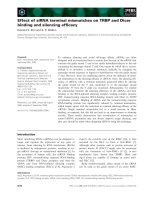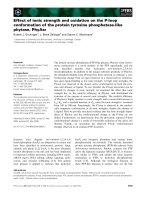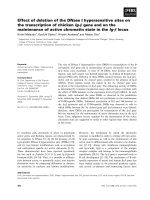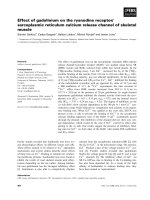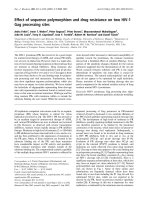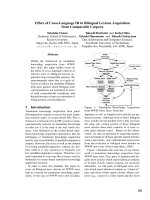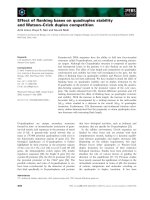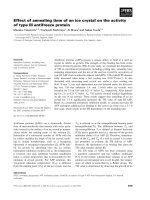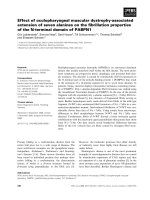Báo cáo khoa học: "Effect of storage conditions on germination in Touki seeds (A. acutiloba Kitagawa) on the different umbel orders" pptx
Bạn đang xem bản rút gọn của tài liệu. Xem và tải ngay bản đầy đủ của tài liệu tại đây (193.61 KB, 5 trang )
Journal of Science and Development April 2008: 83-87 HANOI UNIVERSITY OF AGRICULTURE
Effect of storage conditions on germination
in Touki seeds (
A. acutiloba
Kitagawa) on the different umbel orders
Ninh Thi Phip
*
, Hiroshi Nojima
**
, Tashiro Toru
**
*
Department of industrial plants, faculty of Agronomy, Hanoi University of Agriculture
**
Faculty of Horticulture, Chiba University, Japan
Abstract
Touki seeds (Angelica acutiloba Kitagawa) are best sown immediately after ripening
because of their short viability. This study was conducted to investigate (i) the effects of times
after harvesting (i.e. fresh, one week, one month, and 2 months) at room temperature on
germination of seeds from different umbel orders, and (ii) the effect of storage conditions (i.e.
room temperatures of 25
o
C to 28
o
C, in the refrigerator at 3
o
C to 6
o
C, and in the freezer at -18
o
C to
-20
o
C) on germination in seeds at 2 months after harvesting. The results showed that the
germination percentage and mean germination time were not significantly different in the seeds
sown at harvest, one week or at one month after harvesting. The germination ability decreased
significantly in seeds stored in room conditions 2 months after harvesting. The germination
ability did not change in seeds stored in the refrigerator and in the freezer 2 months after
harvesting. It is necessary to store seeds in the refrigerator (3
o
C-6
o
C) or in the freezer (-18
o
C to -
20
o
C) immediately after drying to maintain seed viability.
Keyword: Angelica acutiloba Kitagawa, Seed Germination, Storage Condition, Time
1. INTRODUCTION
Touki seeds (Angelica acutiloba Kitagawa)
have short viability. Seed germination ability is
lost rapidly soon after harvesting (Huxley,
1992). Pham et al. (1998) also found that
germination ability of Touki seeds decreased
from 73.3% (at harvesting) to 26.6% (four
months storage room conditions). They
indicated that the best condition for storing the
Touki seeds is 18
o
C-20
o
C with 2.6% moisture
content. In Viet Nam, most Touki seeds
matured from July to August, and were sown in
the beginning of October. Changes in the
germination ability of Touki seeds (i.e.
germination percentage and time) from
maturing to sowing under the room condition
have not been fully understood. On the other
hand, several studies noted that some seeds of
Angelica species (i.e. A. gigas, A. archagelica)
required stratification after harvesting or before
sowing to germinate (Ojala, 1985; Butalo and
Badola, 2004). Therefore, the storage
conditions for Touki seeds from harvesting to
sowing should be analyzed.
The main objectives of this study were: (i)
to investigate the effect of times after
harvesting (i.e. fresh, 1 week, 1 month and 2
months) at room conditions on germination
percentage and different umbel orders, and (ii)
to investigate the effect of storage conditions
(i.e. room conditions of 25
o
C to 28
o
C,
refrigerated conditions of 3
o
C to 6
o
C and frozen
conditons of -18
o
C to -20
o
C) on the germination
of seeds derived from the different umbel
orders at 2 months after harvesting.
83
Ninh Thi Phip, Hiroshi Nojima, Tashiro Toru
2. MATERIALS AND METHODS
Seed collections
Seeds of each umbel (i.e. primary,
secondary and tertiary) were harvested
separately. The seeds were classified according
to their time after harvesting and storage
conditions as follows: (i) fresh seeds (just after
harvesting), (ii) seeds dried at room temperature
for one week, (iii) seeds packed in paper (No
2042, Yakuhoushi, Hakuai Tokyo, Japan) and
kept at room conditions for one month, and (iv)
seeds stored for 2 months in the three
temperature conditions as followings: (iv.1)
seeds were packed in paper, sealed in
polyethylene bags and kept at room conditions
from July to September (25
o
C to 28
o
C; (iv.2)
seeds were packed in paper and sealed in
polyethylene bags and then refrigerated at 3 to
6
o
C; (iv.3) seeds were packed in paper and
sealed in polyethylene bags and then frozen (-
18
o
C to -20
o
C).
Germination test
To avoid fungal contamination, all seed
surfaces were sterilized in sodium hypochlorite
(NaOCl) containing 1% active chlorine for 20
minutes and washed thoroughly with distilled
water prior to sowing. One hundred filled seeds
for each treatment with five replications were
placed in a Petri dish (6-cm in diameter) with
filter paper (No 2 Advantec, Japan) and 7 ml of
distilled water for a germination test.
Germination was in darkness at 20
o
C and was
recorded every day until no more seed
germinated. Seed was classified as germinated
when the radicle protruded from the seed coat.
Seed germination percentages were
arcsine-transformed to meet the assumptions of
ANOVA. Germination percentages and mean
germination time (MGT) were calculated with
standard errors. MGT was computed according
to the formula (Bewley and Black, 1994):
MGT =Σ (t × n
i
)/ Σ n
i
where t is the time (in days) starting from
day 0 ( the day of sowing); n
i
is the number of
seeds that completed germination on day t; and
n
j
is the number of seeds with complete
emergence of the seedlings on day t.
The Tukey test was used to compare the
significant differences of the treatment means.
3. RESULTS
Effect of time after harvesting different
umbel orders on the germination percentage
Germination percentage
70
75
80
85
90
95
100
Fresh 1 week 1 month 2 months
Time after harves ting (days)
Germination percentage (%)
P
S
T
Fig.1. Effects of time after harvesting on germination percentage in Touki seeds
(Angelica acutiloba Kitagawa). SE = error bar. P: Primary; S: Secondary; T: Tertiary
84
Effect of storage conditions on germination
The results in Fig.1 showed that
germination percentage of seeds stored at
room conditions from harvesting to one month
after harvesting did not change significantly
(varied from 94.4% to 96.3%). Maximum
germination percentage was found from seed
lots sown one week after harvesting (96.3%).
Among the umbel orders, the germination
percentage in seeds on the primary umbel was
relatively higher than those on the secondary
and tertiary umbels. The significantly lowest
value of germination percentage (P<0.05) was
obtained in the seeds stored 2 months after
sowing (90.0%), in which the germination
percentage decreased sharply in seeds on the
primary umbel (85.4%) compared to those on
the secondary (91.4%) and tertiary umbels
(93.2%).
Mean germination time
5
7
9
11
13
15
17
19
21
Fresh 1 week 1 month 2 months
Time after harvesting (days)
Mean germination time (days)
P
S
T
Fig 2. Effect of time after harvesting on mean germination time in Touki seeds.
SE = error bar. P: Primary; S: Secondary; T: Tertiary
Mean germination time was affected by
times after harvesting (Fig.2). The seeds sown
one week after harvesting exhibited earliest and
fastest germination (13.4 days). From one week
to 2 months after harvesting, mean germination
time increased with increasing time after
harvesting. The mean germination time was the
longest for seeds sown at 2 months after
harvesting (17.6 days). Fresh seeds germinated
a little slower than those sown at one week after
harvesting, and were not significantly different
from those sown at one month after harvesting.
At 2 months after harvesting, mean
germination time in seeds on the primary,
secondary and tertiary umbels was not
significantly different (Fig. 2).
Effect of storage temperature conditions on
the germination percentage and time in seeds
derived from the different umbel orders at 2
months after harvesting
Germination percentage
The germination percentage was strongly
affected by storage conditions. Two months after
harvesting, germination percentage in seeds
stored in the refrigerator (3
o
C to 6
o
C) and in the
freezer (-18
o
C to-20
o
C) was 96.3% and 96.9%,
respectively. These percentages are similar to
those in seeds harvested fresh or at one week.
The germination percentage was significantly
lower (P<0.05) in seeds stored in the room
conditions (25
o
C - 28
o
C) (90.0%) (Fig.3).
85
Ninh Thi Phip, Hiroshi Nojima, Tashiro Toru
70
75
80
85
90
95
100
Freezer
Refrigerator
Room
Storage conditions
Germination percentage (%)
P
S
T
Fig 3. Effect of storage conditions on germination percentage in Touki seeds
SE = error bar. P: Primary; S: Secondary; T: Tertiary.
Mean germination time
Two months after harvesting, mean
germination time (MGT) was also affected by
storage conditions (Fig. 4). MGT in seeds
stored in the refrigerators (13.5 days) and in the
freezer (13.1 days) was similar to those in fresh
seeds. In contrast, seeds stored in the room
conditions germinated significantly slower
(P<0.05) (17.6 days).
10
12
14
16
18
20
22
Freezer
Refrigerator
Room
Storage conditions
Mean germination time (days)
P
S
T
Fig 4. Effect of storage conditions on mean germination time in Touki seeds. SE = error bar. P:
Primary; S: Secondary; T: Tertiary.
4. DISCUSSION
Some seeds of Angelica species require
pretreatments to germinate after harvesting. For
example, seeds of Angelica archangelica L.
required pretreatment with stratification at 5℃
and incubation under light condition to germinate
(Ojala, 1985). Seeds of Angelica glauca required
pretreatment with KNO
3
and NaHClO
3
for
germination (Butola and Balado, 2004). In
contrary to these results, in the present study,
Touki seeds were able to germinate without any
pretreatment, and a high germination percentage
was obtained from the fresh seeds.
In room conditions, the germination
percentage of seed decreased slightly at one
86
Effect of storage conditions on germination
month and decreased strongly at 2 months after
harvesting. At 2 months after harvesting, more
time was required for germination, compared to
the fresh seeds, one week and one month. This
indicates that germination ability of seeds
decreased following the times after harvesting.
Boros (1980) reported that the germination
ability of Angelica archangelica L seeds
reduced quite rapidly under room conditions.
Pham et al. (1998) showed that the seeds of
Touki absorbed moisture rapidly and began to
reduce their germination percentage from
73.3% to 64.3% after eight months of storage.
Moreover, the germination ability reduced
sharply (39.6%) after 1 year in cold storage
conditions (18-22
o
C) in Viet Nam.
In the seeds kept in room conditions for 2
months after harvesting, the germination
percentage decreased more rapidly in seeds set
on the primary umbel than those on the
secondary and tertiary umbels. This is because
the heavier seeds that set on the primary umbel
more easily lost viability than the lighter seeds
which set on the secondary and tertiary umbels.
Thompson and Grime (1979) reported that
smaller seeds in Apiaceae family may have
greater longevity in a seed bank than bigger
seeds. However, the present results also
indicated that the germination ability (i.e.
germination percentage and MGT) did not
change in seeds stored in the refrigerator or in
the freezer 2 months after harvesting, indicating
that storage temperatures affected the
germination ability of Touki seeds. Boros
(1980) also reported that germination ability of
A. archangelica L. did not change during dry
storage for 1 year at 5
o
C, while decreased
strongly in the room temperature. In our
previous experiment, Ninh et al. (2006)
reported that Touki seeds stored at -18
o
C to -
20
o
C in silvered paper bags for 2 years still
showed high germination percentage (83.0%).
Finally, Touki seeds can germinate just at
harvesting time without any pretreatment and the
germination ability decreased at 2 months after
harvesting under room conditions. Therefore, it is
necessary to store seeds in cold conditions of
refrigeration (3 - 6
o
C) or freezing (-18
o
C to -
20
o
C) just after drying to keep germination ability
until seeds will be sown.
REFERENCES
Boros, A.R(1980). Germination ability,
viability and storage experimental results
with angelica (Angelica archangelica L.)
seeds in: ISTA Congress Preprint (Wien)
19: 11.
Bewley, J. D. and M. Black (1994). Seeds:
Physiology of Development and
Germination. Plenum Press (New York)
p.445.
Butola, J. S. and H. K. Badola (2004). Effect of
pre-sowing treatment on seed
germination and seedling vigorour in
Angelica glauca, a threatened medicinal
herb. Current Science 87: 796-799.
Huxley, A (1992). The New RHS Dictionary of
Gardening. MacMillan Press ISBN 0-
333-47494-5.
Ninh, T. P., Nojima, H., Tashiro, T. (2006).
Effect of seed selection based on seed
weight and specific gravity on seed
germination and seedling emergence and
growth in Angelica acutiloba Kitagawa.
Jpn. J. Trop. Agr. 50: 154-162.
Ojala, A. (1985). Seed dormancy and
germination in Angelica archagelica
subsp. archangelica (Apiaceae). Ann.Bot.
Fennici 22:55-62.
Pham, V. Y., Tran, V. D. and Bui, T. B. (1998).
Researching on characteristic of Angelica
acutiloba Kitagawa seeds. Monthly
Journal of Science Technology and
Economic Management 1: 38-39*
87
